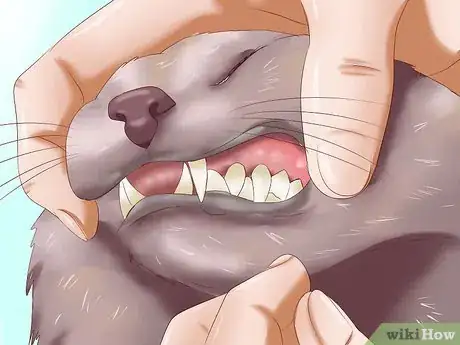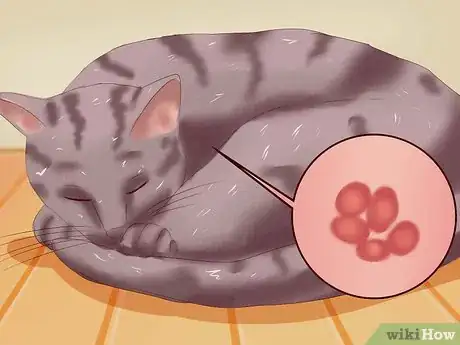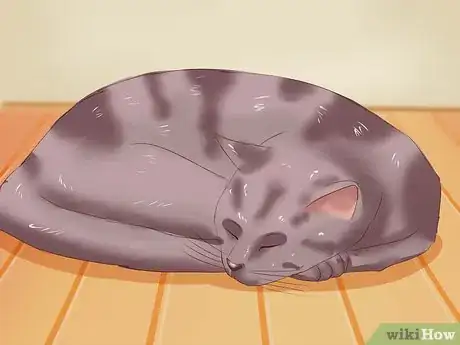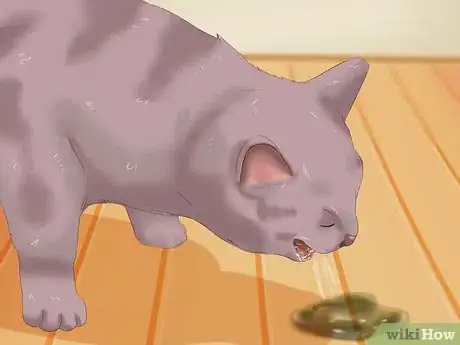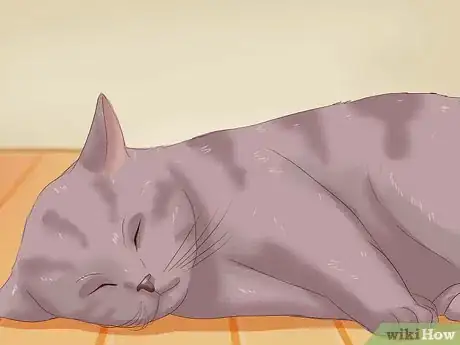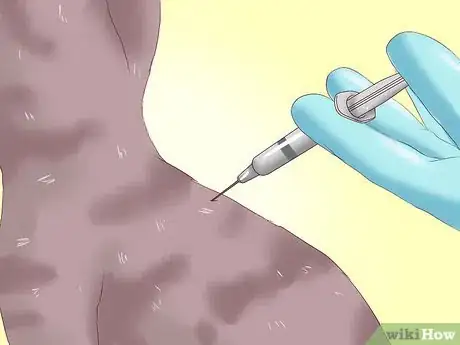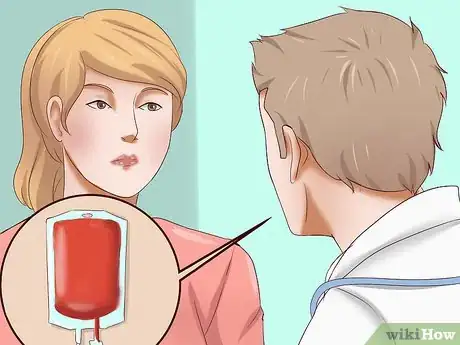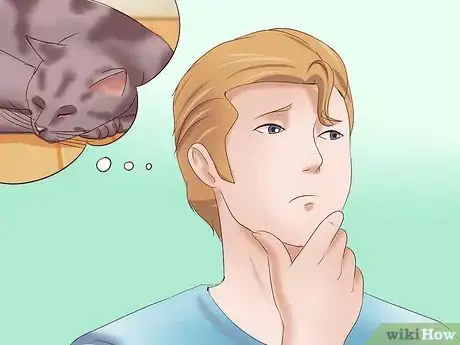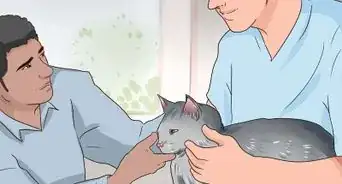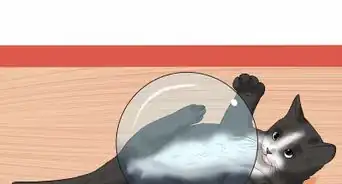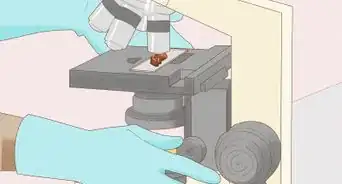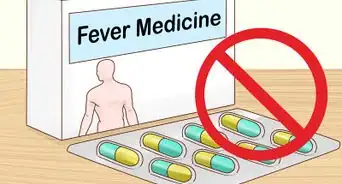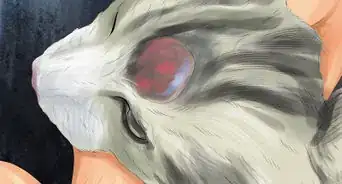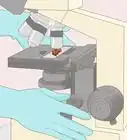This article was co-authored by Jamie Freyer, DVM. Dr. Jamie Freyer is a Licensed Doctor of Veterinary Medicine based in Washington. With over ten years of experience in clinical practice and industry, she specializes in veterinary medicine and surgery, animal behavior, and animal genetics. Dr. Freyer holds a BS in Life Science from The University of Portland and a DVM from Oregon State University.
This article has been viewed 47,775 times.
One of the challenging things about cats is knowing when they are ill. By their very nature cats like to eat and sleep, and many conditions (such as anemia) are largely characterized by lack of energy. It can therefore be difficult to recognize when a cat has stepped from being relaxed over into ill health.
Steps
Recognizing Anemia
-
1Check your cat’s gums in the case of an accident or trauma. They should be a healthy pink color like our own. An anemic animal has pale pink or even white gums.[1] The gums can also be pale because of shock, but in this situation regardless of whether the cause is anemia or shock, get the cat seen by a vet.
- Given a recent history of trauma, pale gums are a sign the cat need supportive care such as intravenous fluids.
-
2Be aware that ill health can lead to anemia. Each red blood cell lives for up to 100 days, and unless the animal experiences rapid blood loss (trauma), it is common for anemia to develop slowly when cells die but aren't replaced. The bone marrow is the factory that makes red blood cells and in older cats, the active bone marrow slowly gets replaced with non-functional scar tissue. Thus the body's ability to make new cells slowly dwindles.
- The other side of the coin is the red blood cells, and just like every cell in the body it has a natural lifespan programmed in. It is inevitable that over time these red blood cells are recognized as "old" by the spleen and destroyed.
Advertisement -
3Look for symptoms. In the early stages there are few symptoms, and indeed the slow decrease in numbers of red blood cells gives the body time to adapt to less oxygen, which means the signs of anemia are masked for even longer. Only when the anemia is quite severe will that cat start to show signs. These include[2] :
- Low energy levels (sleeping more!)[3]
- General weakness
- Lethargy. This might show itself as the cat who used to greet you, no longer getting up when you come home.[4] The hunter who spent all day in the fields may stay home asleep, or the cat who groomed obsessively no longer bothering to take care of his coat - the signs can be very subtle.[5]
- Cats with anemia often have a poor appetite, so eating loss and weight loss (although general signs) should be noted.
-
4Look for symptoms of an underlying condition causing the anemia. It is also likely that the cat has an underlying health issue which is causing the anemia. You are more likely to spot signs of this causative disease, than the anemia. Some of the most common diseases which can cause anemia are:
- Kidney Disease: Increased thirst, wetting more often, vomiting, poor appetite.
- Cancer, especially of the bowel: Vomiting, diarrhea, blood in the feces, weight loss, poor appetite, increased thirst, low energy levels
- Gastric Ulcers: Recent history of NSAID medication (such as metacam), vomiting, vomit sometimes containing blood
- External parasites: Presence of lice or fleas in the fur, itchiness. If the cat is otherwise well, killing the parasites removes the cause of the anemia. Provided the bone marrow is functioning and pushing out replacement red blood cells, within 2-3 weeks the cat should be feeling much stronger. Unless the cat was dangerously anemic, in which case he would be weak, listless, and poorly, a vet is unlikely to give a blood transfusion if the initial problem is identified and addressed.
-
5Understand that some underlying conditions will not have any symptoms. Unfortunately, problems such as bone marrow disease are largely "silent" - that is they don't show signs other than a decreased product of red blood cells.
- Also, some conditions such as autoimmune hemolytic anemia (where the body's immune system destroys it's own red blood cells in a case of mistaken identity) the deterioration can happen within a few days.
- However, very rapid hemolysis (breaking down of red blood cells) can flood the plasma with hemoglobin products which have a yellow tinge. The latter will color the urine bright orange and cause the oral membranes and whites of the eye to be jaundiced (bright yellow).
Seeking Medical Help
-
1Have your vet check your pet’s gums. The vet will check your pet's gums, and have a high suspicion of anemia if they are pale and there is no recent history of trauma (shock).
- However, some caution needs to be exercised because some cats gums appear pale at the vet's because of fear - adrenaline flooding a fearful cat's system causes peripheral blood vessels in the gum to contract and squeeze the blood out of them. This mechanism redirects blood to the muscles for a quick getaway!
-
2Get blood work done for your cat. The standard test is to draw blood the jugular vein in the cat's neck, or the cephalic vein on the foreleg. The blood is placed in an EDTA tube (which includes an anticoagulant to stop the blood clotting), then transferred to a capillary tube (a fine bore glass tube) and centrifuged for 3 to 4 minutes. This packs the red blood cells down under gravity, separating them out from the fluid plasma in which they are suspended. This spun down sample is used to calculate the percentage of red blood cells present.
- This is done by laying the capillary tube (a fine tube into which the blood was put prior to centrifugation) on a special gauge. The length of red blood cells is divided by the length of the fluid as a whole and multiplied by 100 to give a percentage. This reading is also known as a packed cell volume or PCV. If this figure is below 33% the cat is anemic.
- A PCV between 21-33% is considered mild anemia, between 15-20 % is moderate anemia, and below 15 % is severe anemia[6]
-
3Understand that the vet most likely won’t give your cat iron. Iron deficiency anemia is rare in cats and usually arises because of chronic blood loss in a cat eating a poorly balanced diet. There is rarely anything to be gained by supplementing a cat with iron.
-
4Talk to your vet about a transfusion. Severely anemic cats may need a blood transfusion in order to buy time until the underlying cause of the anemia can be diagnosed and treated. Moderately or mildly anemic cats do not need transfusion because if the bone marrow is working, they will generate new red blood cells. Once the source of blood cell loss or destruction is identified and treated, the cat will make more cells than she loses and the anemia gradually improve.[7]
- The exception is bone marrow problems which usually carry a grave outlook. Most commonly the bone marrow runs out of "baby" red blood cells because it's used them all up, and so the cat is unable to make new cells. These cats remain anemic, become progressively weaker, and other than repeated blood transfusions there is little by way of treatment and euthanasia may be the most humane option.
Understanding Anemia in Cats
-
1Understand what anemia is. The term anemia refers to a reduced number of circulating red blood cells or a decrease in the amount of hemoglobin in the blood. The amount of red blood cells if most commonly discussed in percentage terms.
- A normal percentage in the cat is around 33 to 50%. In a given volume of blood this tells you that 33-50% of it is occupied by red blood cells.[8]
- Red blood cells contain haemoglobin, and indeed the hemoglobin plays a vital role in delivering oxygen to the body's tissue. Deprived of oxygen, organs, muscles and tissue cannot function properly, and leads to clinical signs.
-
2Be aware of why anemia happens. Anemia is a symptom rather than a diagnosis in its own right. There are many conditions that cause anemia, but the reasons can be proudly broken down into groups[9] :
- Anemia because of blood loss: This includes hemorrhage, such as after a traffic accident. There are many ways to lose blood including hemorrhage from gastro-intestinal ulcers, inflamed bowels, parasitism (lice or fleas sucking blood)
- Anemia because of damage to red blood cells: Also a form of blood loss, this includes red blood cells being destroyed because of autoimmune disease, parasitism (Mycoplasma felis), or damaged passing through a tumor
- Anemia due to lack of blood cell production: Most commonly this is bone marrow disease due to cancer or exhaustion of the bone marrow germ cells. It can also include anemia due to iron deficiency leading to lack of hemoglobin synthesis.
-
3Understand that diagnosing anemia can be challenging. Determining the cause of the anemia can be a complex and involved process that requires blood tests, blood smears, and imaging such as radiographs, ultrasound, or an MRI scan. However, the first step is to recognize that the cat is anemic.
Expert Q&A
-
QuestionWhat is the most common cause of anemia in cats?
 Jamie Freyer, DVMDr. Jamie Freyer is a Licensed Doctor of Veterinary Medicine based in Washington. With over ten years of experience in clinical practice and industry, she specializes in veterinary medicine and surgery, animal behavior, and animal genetics. Dr. Freyer holds a BS in Life Science from The University of Portland and a DVM from Oregon State University.
Jamie Freyer, DVMDr. Jamie Freyer is a Licensed Doctor of Veterinary Medicine based in Washington. With over ten years of experience in clinical practice and industry, she specializes in veterinary medicine and surgery, animal behavior, and animal genetics. Dr. Freyer holds a BS in Life Science from The University of Portland and a DVM from Oregon State University.
Licensed Veterinarian Some anemic cats may have pale gums right around their teeth. They may also have pale mucous membranes, like the conjunctiva in their eyes.
Some anemic cats may have pale gums right around their teeth. They may also have pale mucous membranes, like the conjunctiva in their eyes. -
QuestionCan anemia cause extreme fatigue?
 Jamie Freyer, DVMDr. Jamie Freyer is a Licensed Doctor of Veterinary Medicine based in Washington. With over ten years of experience in clinical practice and industry, she specializes in veterinary medicine and surgery, animal behavior, and animal genetics. Dr. Freyer holds a BS in Life Science from The University of Portland and a DVM from Oregon State University.
Jamie Freyer, DVMDr. Jamie Freyer is a Licensed Doctor of Veterinary Medicine based in Washington. With over ten years of experience in clinical practice and industry, she specializes in veterinary medicine and surgery, animal behavior, and animal genetics. Dr. Freyer holds a BS in Life Science from The University of Portland and a DVM from Oregon State University.
Licensed Veterinarian Anemia can definitely make your cat seem more tired, lethargic, and different than their usual self.
Anemia can definitely make your cat seem more tired, lethargic, and different than their usual self. -
QuestionI just found out that my cat is anemic, and now I am waiting for another blood test to rule out leukemia. She is not drinking or eating and sleeps all the time. Is the not drinking water normal?
 SmereddyCommunity AnswerNo, you need to take her to the vet and find out what to do.
SmereddyCommunity AnswerNo, you need to take her to the vet and find out what to do.
References
- ↑ Jamie Freyer, DVM. Licensed Veterinarian. Expert Interview. 8 October 2021.
- ↑ Haematologic disorders. Raskin. Clinical Medicine of the Dog and Cat. 2nd edition. Manson Publishing. p227-231
- ↑ Jamie Freyer, DVM. Licensed Veterinarian. Expert Interview. 8 October 2021.
- ↑ Jamie Freyer, DVM. Licensed Veterinarian. Expert Interview. 8 October 2021.
- ↑ Jamie Freyer, DVM. Licensed Veterinarian. Expert Interview. 8 October 2021.
- ↑ Anemia diagnosis and treatment. Loar. Consultations in Feline Internal Medicine. WB Saunders. p 469-487
- ↑ Interpretation of Laboratory Results for Small Animal Clinicians. Bush. Publisher Wiley-Blackwell
- ↑ Anemia diagnosis and treatment. Loar. Consultations in Feline Internal Medicine. WB Saunders. p 469-487
- ↑ Interpretation of Laboratory Results for Small Animal Clinicians. Bush. Publisher Wiley-Blackwell
